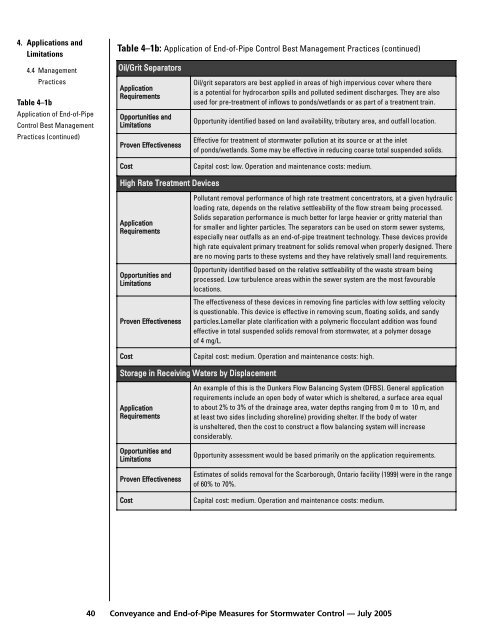Conveyance and End-of-Pipe Measures for Stormwater - FCM
Conveyance and End-of-Pipe Measures for Stormwater - FCM
Conveyance and End-of-Pipe Measures for Stormwater - FCM
You also want an ePaper? Increase the reach of your titles
YUMPU automatically turns print PDFs into web optimized ePapers that Google loves.
4. Applications <strong>and</strong><br />
Limitations<br />
4.4 Management<br />
Practices<br />
Table 4–1b<br />
Application <strong>of</strong> <strong>End</strong>-<strong>of</strong>-<strong>Pipe</strong><br />
Control Best Management<br />
Practices (continued)<br />
Table 4–1b: Application <strong>of</strong> <strong>End</strong>-<strong>of</strong>-<strong>Pipe</strong> Control Best Management Practices (continued)<br />
Oil/Grit Separators<br />
Application<br />
Requirements<br />
Opportunities <strong>and</strong><br />
Limitations<br />
Proven Effectiveness<br />
Oil/grit separators are best applied in areas <strong>of</strong> high impervious cover where there<br />
is a potential <strong>for</strong> hydrocarbon spills <strong>and</strong> polluted sediment discharges. They are also<br />
used <strong>for</strong> pre-treatment <strong>of</strong> inflows to ponds/wetl<strong>and</strong>s or as part <strong>of</strong> a treatment train.<br />
Opportunity identified based on l<strong>and</strong> availability, tributary area, <strong>and</strong> outfall location.<br />
Effective <strong>for</strong> treatment <strong>of</strong> stormwater pollution at its source or at the inlet<br />
<strong>of</strong> ponds/wetl<strong>and</strong>s. Some may be effective in reducing coarse total suspended solids.<br />
Cost Capital cost: low. Operation <strong>and</strong> maintenance costs: medium.<br />
High Rate Treatment Devices<br />
Application<br />
Requirements<br />
Opportunities <strong>and</strong><br />
Limitations<br />
Proven Effectiveness<br />
Pollutant removal per<strong>for</strong>mance <strong>of</strong> high rate treatment concentrators, at a given hydraulic<br />
loading rate, depends on the relative settleability <strong>of</strong> the flow stream being processed.<br />
Solids separation per<strong>for</strong>mance is much better <strong>for</strong> large heavier or gritty material than<br />
<strong>for</strong> smaller <strong>and</strong> lighter particles. The separators can be used on storm sewer systems,<br />
especially near outfalls as an end-<strong>of</strong>-pipe treatment technology. These devices provide<br />
high rate equivalent primary treatment <strong>for</strong> solids removal when properly designed. There<br />
are no moving parts to these systems <strong>and</strong> they have relatively small l<strong>and</strong> requirements.<br />
Opportunity identified based on the relative settleability <strong>of</strong> the waste stream being<br />
processed. Low turbulence areas within the sewer system are the most favourable<br />
locations.<br />
The effectiveness <strong>of</strong> these devices in removing fine particles with low settling velocity<br />
is questionable. This device is effective in removing scum, floating solids, <strong>and</strong> s<strong>and</strong>y<br />
particles.Lamellar plate clarification with a polymeric flocculant addition was found<br />
effective in total suspended solids removal from stormwater, at a polymer dosage<br />
<strong>of</strong> 4 mg/L.<br />
Cost Capital cost: medium. Operation <strong>and</strong> maintenance costs: high.<br />
Storage in Receiving Waters by Displacement<br />
Application<br />
Requirements<br />
Opportunities <strong>and</strong><br />
Limitations<br />
Proven Effectiveness<br />
An example <strong>of</strong> this is the Dunkers Flow Balancing System (DFBS). General application<br />
requirements include an open body <strong>of</strong> water which is sheltered, a surface area equal<br />
to about 2% to 3% <strong>of</strong> the drainage area, water depths ranging from 0 m to 10 m, <strong>and</strong><br />
at least two sides (including shoreline) providing shelter. If the body <strong>of</strong> water<br />
is unsheltered, then the cost to construct a flow balancing system will increase<br />
considerably.<br />
Opportunity assessment would be based primarily on the application requirements.<br />
Estimates <strong>of</strong> solids removal <strong>for</strong> the Scarborough, Ontario facility (1999) were in the range<br />
<strong>of</strong> 60% to 70%.<br />
Cost Capital cost: medium. Operation <strong>and</strong> maintenance costs: medium.<br />
40 <strong>Conveyance</strong> <strong>and</strong> <strong>End</strong>-<strong>of</strong>-<strong>Pipe</strong> <strong>Measures</strong> <strong>for</strong> <strong>Stormwater</strong> Control — July 2005
















